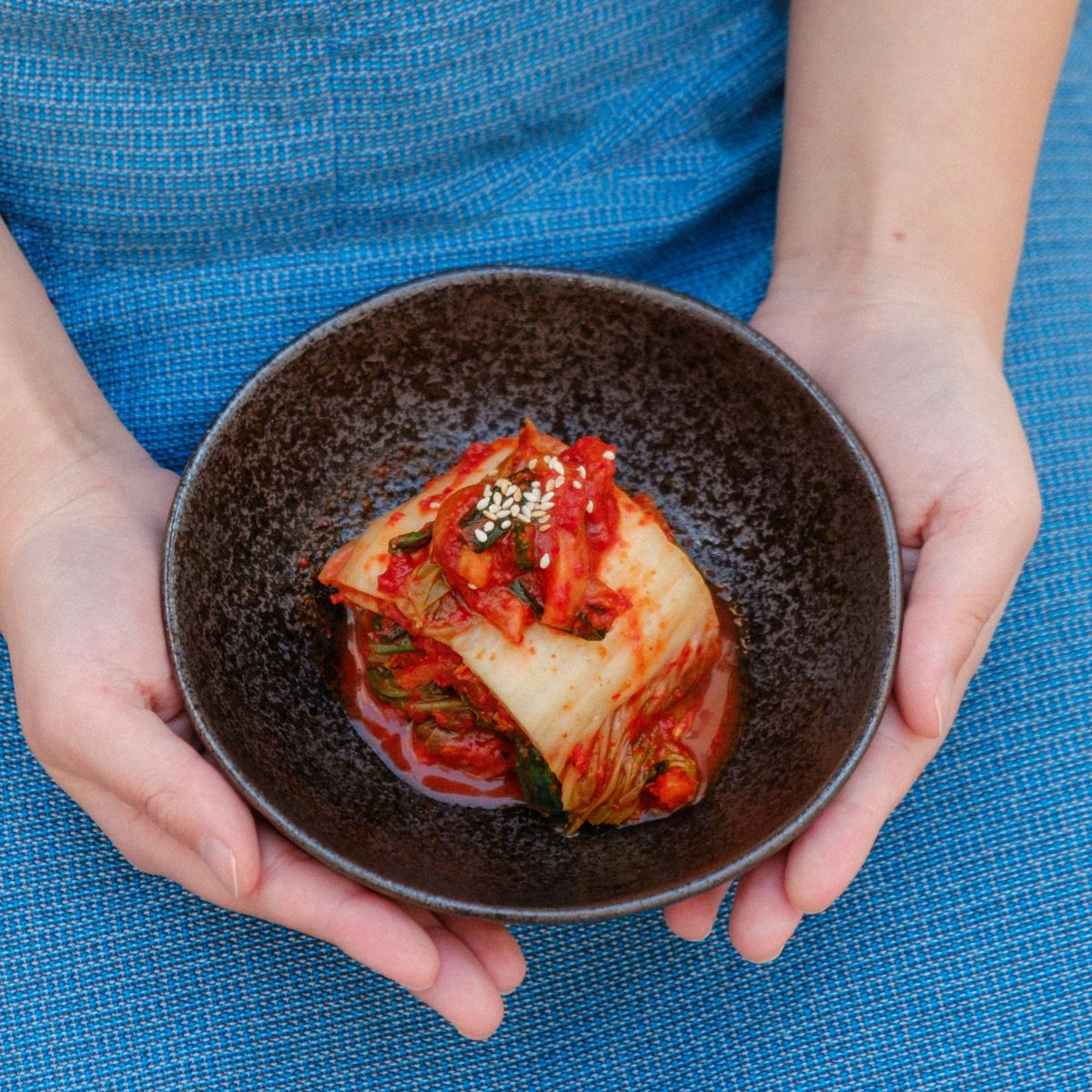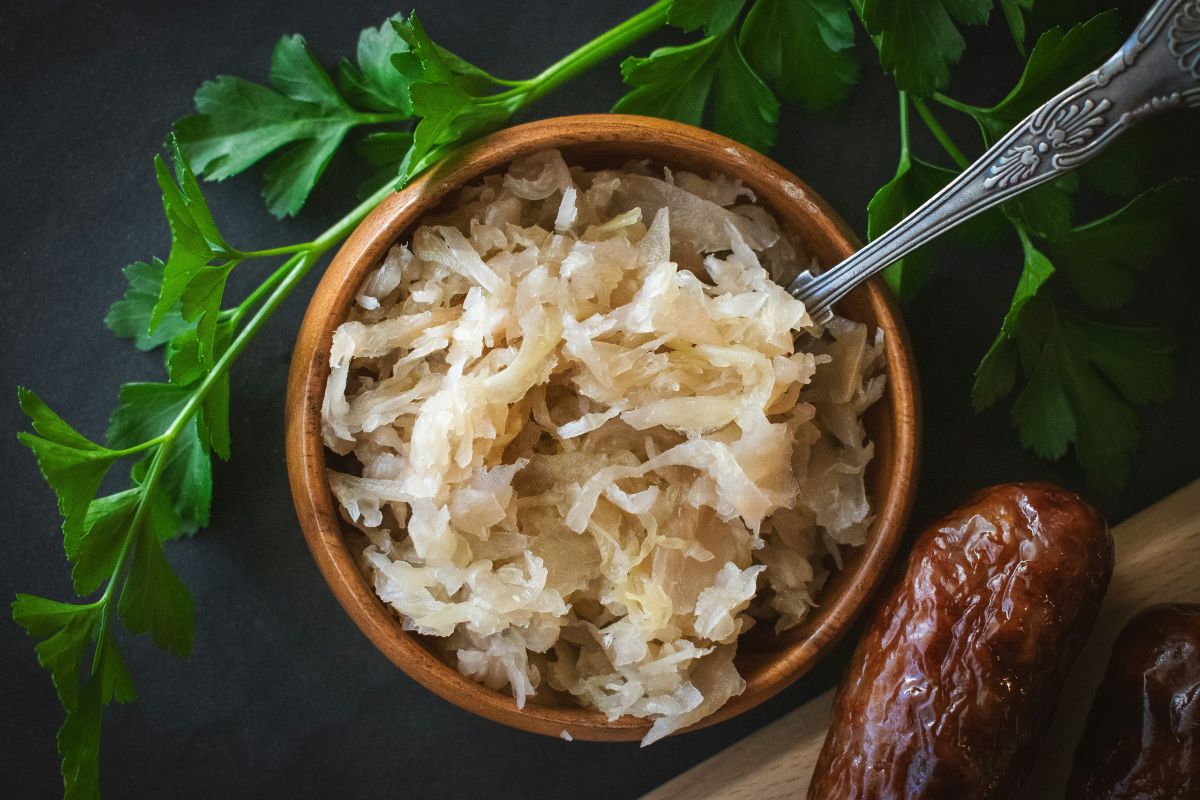Probiotics are live bacteria and yeasts that are good for your digestive system and overall health. They’ve become increasingly popular because of their proven benefits in improving gut health, which in turn can improve our immune, metabolic, cardiovascular, mental, and even skin health.
Sales of probiotics supplements have exploded and everyone seems to be talking about which supplements are best and how many billions of CFUs (colony-forming units) to consume.
However, many experts agree it’s better to consume probiotics and other nutrients through foods rather than supplements. More research needs to be conducted on probiotic supplements which aren’t regulated like medications. So the quality and actual probiotic content can vary from capsule to capsule.
In addition, a regular change in eating habits rather than a temporary supplement fix can have a better, longer-term impact on your gut health.
Some gut health experts refer to 4 K’s for probiotics foods – kefir, kombucha, kimchi, and kraut (as in sauerkraut).
In this article, we introduce not just those four, but seven powerful foods with probiotic benefits and how you can incorporate them into your diet.

Photo of kimchi thanks to Portoguese Gravity.
What Are Probiotics?
Probiotics are specific strains of live bacteria and yeasts that provide health benefits, particularly for the gut, when consumed in adequate amounts.
They can be found in certain foods that have undergone a fermentation process where natural bacteria or yeasts convert sugars into acids or alcohol. These fermented foods improve gut health by introducing beneficial bacteria in your gut feed.
When your gut has a good balance of beneficial bacteria, it supports digestion and can boost your immune system and reduce inflammation in the body.
The Importance of Probiotic Foods for Gut and Overall Health
Probiotics from natural foods may be more effective than supplements due to their bioavailability. By eating probiotic foods, you help your body absorb and use their nutritional content more effectively. In addition, probiotic foods come with other nutrients that support your gut and overall health.
Quick fixes can not permanently improve gut health. Probiotics in supplements do not take permanent residence in your gut. While they could make temporary changes to the composition of your gut microbiome, longer-term and regular changes to your eating habits can be more effective in improving and maintaining gut health.
So what are the best fermented foods to add to your diet for their probiotic benefits?

Photo of yogurt thanks to Daniel Cabrile.
Yogurt
Besides healthy doses of calcium and protein, yogurt is a great source for the good, live bacteria and yeasts that your gut loves. Look for “live and active cultures” on yogurt labels. To provide the desired benefits, bacteria in yogurt must be alive.
Ideally, select plain yogurt with no added sugar. Plain yogurt contains some natural sugar known as lactose, so don’t be alarmed when “sugars” appear on the label. Focus on the “added sugars” on the label and avoid yogurts that are flavored, fruited, or have sugary toppings. You can sweeten and flavor yogurt yourself by adding fruit, vanilla, cinnamon, or natural flavorings like honey or maple syrup (in quantities that you can control).
How to Add Yogurt to Your Diet
- Smoothies: Blend yogurt with fruits, vegetables, and a bit of honey for a tasty and nutritious smoothie.
- Breakfast Topping: Add yogurt on top of your cereal, granola, or oatmeal for a creamy texture and extra protein.
- Snacks: Enjoy a small bowl of yogurt with a sprinkle of nuts, seeds, or fruit as a quick and healthy snack.
- Sauces and Dressings: Use yogurt as a base for savory sauces or salad dressings instead of heavier options like mayonnaise.
- Desserts: Mix yogurt with a bit of fruit and a touch of sweetener for a simple and delicious dessert.
Kefir
The amount of probiotics in kefir can vary depending on the brand and fermentation process, but generally, kefir contains a diverse range of probiotic strains. On average, a serving of kefir (about 1 cup or 240 ml) can provide around 10 to 20 billion CFUs (colony-forming units) of probiotics.
This high probiotic content supports gut health and contributes to a balanced microbiome. Plus, its liquid form allows you to more flexibility to incorporate it into recipes.
How to Add Kefir to Your Diet:
- Smoothies: Blend kefir with fruits, vegetables, and a bit of honey for a creamy and nutritious smoothie. Try this Matcha Kefir Smoothie with Berries.
- Breakfast: Pour kefir over cereal or granola, or mix it into your oatmeal for a probiotic boost.
- Snacks: Enjoy kefir on its own or with a sprinkle of nuts or seeds as a healthy snack.
- Salad Dressings: Use kefir as a base for creamy salad dressings instead of mayonnaise or heavy cream.
- Baking: Substitute kefir for milk or buttermilk in recipes like pancakes, muffins, or cakes to add a probiotic touch.

Miso
Miso is a traditional Japanese condiment that looks like a thick paste. It’s made from soybeans that are fermented with salt and a starter called koji. Traditionally used in sauces and soup stock, miso offers a salty and umami (savory) flavor to foods.
Aspergillus oryzae fungus is the main probiotic strain found in miso. Research suggests that this strain helps reduce symptoms linked to inflammatory bowel disease and other digestive problems. Read more about miso and how it improves gut health.
How to Add Miso to Your Diet:
- Miso Soup: Prepare a classic miso soup with tofu, seaweed, and vegetables for a comforting and probiotic-rich dish.
- Salad Dressings: Mix miso into vinaigrettes or creamy dressings for a flavorful and savory boost. Try our Miso Sesame Dressing.
- Glaze for Proteins: Add miso as a flavor glaze for proteins like chicken and fish. Try this Oven Baked Miso Chicken or this Air Fryer Miso Cod.
- Marinades: Use miso as a base for marinades to add depth to meats, fish, or vegetables.
- Sauces: Incorporate miso into sauces for a unique umami flavor in dishes like stir-fries or roasted vegetables. Try this Miso Sesame Spinach, Miso Soba Noodles, or Spicy Korean Miso Sauce on Beef Bulgogi.
- Spread: Blend miso with a bit of butter or cream cheese to create a savory spread for sandwiches or crackers.
Above: Oven Baked Miso Chicken
Kimchi
Originating from Korea, kimchi is made from fermented vegetables, including napa cabbage, radishes, green onion, carrots, and garlic. Various seasonings like chili pepper flakes (Gochugaru) and fish sauce or shrimp paste add umami flavor and aid in fermentation.
Kimchi contains various strains of probiotics, including Lactobacillus plantarum and Lactobacillus kimchii, as well as Leuconostoc mesenteroides. These strains help balance gut bacteria and support digestion.
In addition to probiotics, kimchi is packed with vitamins (such as vitamins A, C, and K), minerals (like calcium and iron), and fiber, which contribute to overall health and well-being.
How to Add Kimchi to Your Diet
- With Beef Bulgogi: Enjoy kimchi on its own as a flavorful side dish. One of the most common entrees kimchi complements is Beef Bulgogi.
- In Sandwiches and Wraps: Add kimchi to sandwiches, burgers, or wraps for a tangy, spicy kick and extra crunch.
- In Asian Rice Bowls: Kimchi can add a delightful crunch and tangy flavor to Asian rice bowls. Try it on top of this Korean Bison Bowl.
- In Soups and Stews: Incorporate kimchi into soups, stews, or ramen for added depth of flavor and a probiotic boost.
- On Top of Eggs: Top scrambled eggs, omelets, or egg sandwiches with kimchi for a delicious and nutritious twist.
Tempeh
Rhizopus is the species of fungus used in the fermentation for tempeh. It contributes to tempeh’s probiotic content and aids in nutrient digestion.
Tempeh typically contains 1 to 10 million CFUs (colony-forming units) of probiotics per serving, although it can vary depending on the specific fermentation process and conditions.
A high-quality plant-based protein source, Tempeh helps maintain muscle mass and overall health. It’s also packed with B vitamins and minerals like calcium, magnesium, and iron.
How to Add Tempeh to Your Diet:
- Stir-Fries and Fried Rice: Toss tempeh into stir-fries and rice with vegetables and your favorite sauce for a hearty, protein-packed meal. Try this flavorful Tempeh Fried Rice.
- Salads: Add cubed or crumbled tempeh to salads for extra protein and a satisfying texture.
- Sandwiches and Wraps: Use tempeh as a filling for sandwiches or wraps, either grilled or marinated for added flavor.
- Bowls: Incorporate tempeh into grain bowls with ingredients like quinoa, brown rice, veggies, and a flavorful dressing.
- Grilled ‘Burgers’: Grill tempeh slices or mash and shape them into patties with your favorite seasonings for a tasty burger.
Above: Tempeh Fried Rice
Kombucha
Kombucha is a fermented beverage that tastes tangy and slightly sweet. It has a fizzy, bubbly feel, and comes in a variety of flavors based on what’s added to it.
The key ingredients in kombucha include black or green tea as the base, SCOBY (Symbiotic Culture Of Bacteria and Yeast) for fermentation, sugar to feed the fermentation process, and water. Flavorings, fruits, herbs, or spices contribute to the taste and variety of kombucha.
Kombucha typically contains about 1 to 10 billion CFUs (colony-forming units) of probiotics per serving (about 8 ounces or 240 ml), although the exact amount can vary based on fermentation time, ingredients, and brewing conditions. The probiotics in kombucha, including strains like Saccharomyces and Lactobacillus, support gut health and digestion.
How to Add Kombucha to Your Diet:
- Drink It Straight: Enjoy kombucha on its own as a refreshing beverage straight from the bottle or can.
- Smoothies: Add a splash of kombucha to your smoothies for a tangy twist and extra probiotics.
- Salad Dressings: Use kombucha as a base for homemade salad dressings, replacing vinegar for a unique flavor.
- Cocktails: Mix kombucha with your favorite spirits or non-alcoholic drinks for a fizzy, probiotic boost.

Sauerkraut
Sauerkraut is fermented cabbage that has been seasoned with salt and fermented with beneficial bacteria, such as Lactobacillus species which support gut health and digestion.
A ½ cup serving of sauerkraut typically contains around 1 to 5 billion CFUs (colony-forming units) of probiotics. The exact probiotic content can vary depending on the fermentation process and how long it has been fermented.
Choose raw, unpasteurized sauerkraut to ensure live bacteria. Look for terms like “raw,” “unpasteurized,” or “contains live cultures” on the label, as these indicate that the sauerkraut has not been heat-processed.
How to Add Sauerkraut to Your Diet:
- As a Side Dish: Enjoy sauerkraut on its own or as a tangy side with meals, especially with meats or sausages.
- In Sandwiches and Wraps: Add sauerkraut to sandwiches, burgers, or wraps for extra flavor and crunch.
- On Salads: Top salads with sauerkraut for a zesty twist and added probiotics.
- In Stir-Fries: Mix sauerkraut into stir-fries for a unique flavor and probiotic boost.
- With Eggs: Use sauerkraut as a topping for scrambled eggs, omelets, or breakfast sandwiches.

Photo thanks to Kelsey Todd.
Conclusion
Adding probiotic foods to our diet is a great way to support our gut and overall health. Rather than popping supplements for temporary (and unproven) benefits, weaving tasty, probiotic foods into our regular diet can provide legitimate and lasting benefits.






